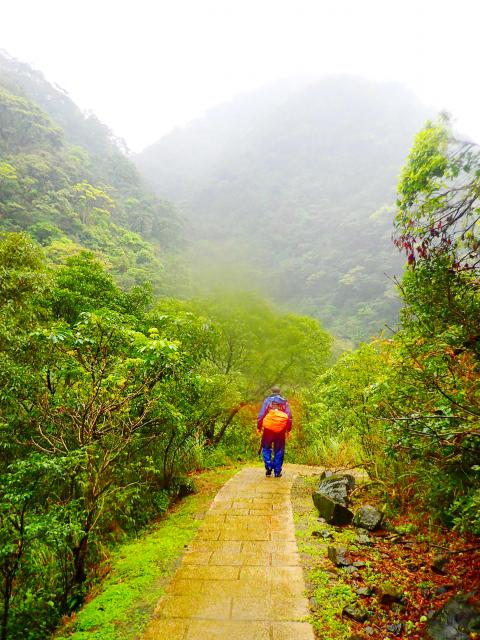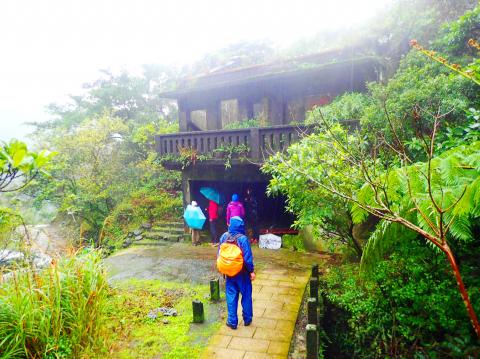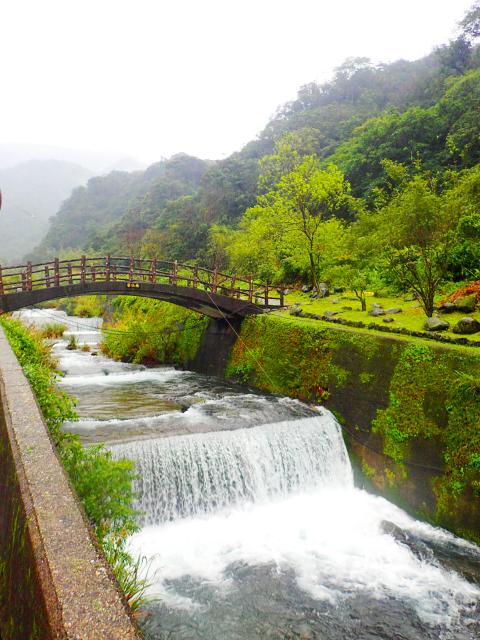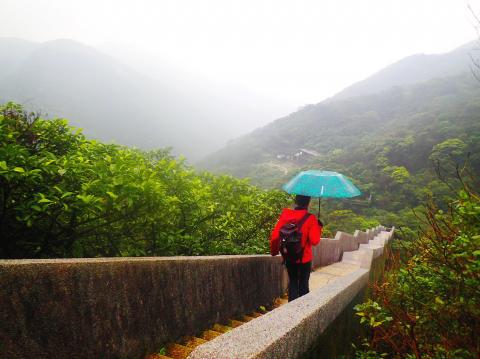The great popularity enjoyed by the Gold Ecological Park (黃金博物園區) in New Taipei City’s Jinguashi (金瓜石), which opened in 2004, is proof that Taiwan’s gold fever era continues to exert a strong pull on the public’s imagination.
Countless other long-forgotten miners also risked their lives toiling to dig out a far less romantic, but extremely profitable mineral from beneath the steep, grassy hills of the area. Why else would they call this substance, which we generally call coal, “black gold?”
It seems coal is far less interesting a substance in the minds of the public, and the success of the Houtong Coalmine Ecological Park (猴硐煤礦博物園區), which was created in 2010 around the old village and mining relics of nearby Houtong Village (猴硐) in Ruifang District (瑞芳), has been only moderate, but Houtong still manages to attract large numbers of visitors every weekend. Ninety percent of these come to see its famed “cat village,” a refuge for several hundred stray cats established by animal-loving locals a year or two before the park.

Photo: Richard Saunders
In their heyday, the nearby gold, copper and coal mines supplied work for many: the coal mines of Houtong alone once employed about 6,000 people. With so many workers (plus their families), many were forced to commute in from other villages and settlements in the area.
With the decline of the mining industry, miners began moving out in search of work elsewhere, and by the late 1970s, the old settlements had become ghost towns.
The more conveniently situated villages close to New Taipei City’s Jiufen District (九份), such as the aforementioned Jinguashi and Houtong — the ones connected to the road network — survived until a new source of income came along in the form of tourism. Less fortunate were the twin settlements of Datcukeng (大粗坑) and Siaocukeng (小粗坑), lying high on the ridge dividing Houtong and Jiufen, and well away from any road. Both were abandoned soon after the closure of the last mines, and left, almost forgotten, to be reclaimed by the forest.

Photo: Richard Saunders
DATCUKENG
The villages can be reached by trails, both starting near Houtong. For Datcukeng, walk out of the village, north along the right bank of the Keelung River, and take a road beside a stream, starting next to Houtong’s former elementary school. Today the school building is a half-abandoned shell, after it was partly destroyed by torrential rains that accompanied Typhoon Xangsane in late October 2000. A huge mudslide swept down the valley, wiping out many houses, killing several residents and severely damaging the school.
Follow the road up beside the stream (which was ducted into a concrete channel following the disaster, to minimize the potential for further mudslides) to the very end, beside which a stone-paved trail continues uphill along the left bank of the cascading stream.

Photo: Richard Saunders
It’s a scenic walk of about 20 minutes to the first houses of the settlement; most have been reclaimed by the thick jungle and are all-but invisible today. It’s hard to believe from the fragmentary remains that can now be seen, but apparently about three hundred families involved in the local mining business once lived here, and it’s said the village had its own elementary school, medical center, shops and even a bar or two.
The village was also the birthplace of Wu Nien-jen (吳念真; born 1952), one of Taiwan’s most famous directors and screenplay writers. He’s perhaps best-known in the West as the scriptwriter for Hou Hsiao-hsien’s (侯孝賢 ) A City of Sadness (悲情城市, 1989), which incidentally was filmed in nearby Jiufen and Jinguashi.
Today a couple of premises beside the main trail are still occupied, but most have already returned to the jungle, are falling into ruin and are all but invisible from the trail. A long and conspicuously out-of-place flight of stone steps, raised on stilts high above the silver grass, climbs the hillside to join a concrete lane, which zigzags up to Provincial Road 102. Turn left and it eventually winds down to Jiufen.

Photo: Richard Saunders
SIAOCUKENG
To get to the second village, Siaocukeng, follow the road beside the Keelung River past the former elementary school and, in a few hundred meters, pass the new school building, erected in a safer location away from the mouth of the valley.
Just after the new school, turn right up a narrow concrete lane beside a signpost and board map, passing the atmospheric remains of a couple of stone-walled houses and an old Earth God Shrine, and crossing two bridges.
The trail begins to climb a long flight of rustic stone steps and soon enters the main area of the former Siaocukeng village. A couple of the stone houses appear to be occupied once more, but the rest of the village has long since been overtaken by the forest. The settlement’s elementary school is now nothing more than a picturesque ruin, and the stumpy former look-out tower is now an inconspicuous shell.
Follow the trail steeply uphill past the last remnants of former miners’ houses, and towards the top of the ridge the trail passes a large Mountain God Shrine (山神廟), built in 1929 for the use of the miners passing through on the way to or from the mines at Jiufen.
Continue uphill, and shortly the trail reaches the top of the ridge, where the woods part to reveal (on a rare clear day in this corner of Taiwan) a magnificent panorama over Jiufen, Keelung Mountain (基隆山) and the Pacific Ocean.
Follow the path down the other side and in 20 minutes or so it joins the road on the edge of Jiufen, at Songde Park (頌德公園). This tiny green space commemorates Yen Yun-nian (顏雲年; 1882 to 1923), the first Taiwanese businessman to persuade the Japanese colonial rulers to sell his (Taiwanese) company rights to mine for gold in the area.
IF YOU GO
Slow trains (and the occasional express) from Taipei Main Station stop at Houtong Station. The trip takes about an hour.
Richard Saunders is a classical pianist and writer who has lived in Taiwan since 1993. He’s the founder of a local hiking group, Taipei Hikers, and is the author of six books about Taiwan, including Taiwan 101 and Taipei Escapes. Visit his Web site at www.taiwanoffthebeatentrack.com.

In Taiwan there are two economies: the shiny high tech export economy epitomized by Taiwan Semiconductor Manufacturing Co (TSMC, 台積電) and its outsized effect on global supply chains, and the domestic economy, driven by construction and powered by flows of gravel, sand and government contracts. The latter supports the former: we can have an economy without TSMC, but we can’t have one without construction. The labor shortage has heavily impacted public construction in Taiwan. For example, the first phase of the MRT Wanda Line in Taipei, originally slated for next year, has been pushed back to 2027. The government

July 22 to July 28 The Love River’s (愛河) four-decade run as the host of Kaohsiung’s annual dragon boat races came to an abrupt end in 1971 — the once pristine waterway had become too polluted. The 1970 event was infamous for the putrid stench permeating the air, exacerbated by contestants splashing water and sludge onto the shore and even the onlookers. The relocation of the festivities officially marked the “death” of the river, whose condition had rapidly deteriorated during the previous decade. The myriad factories upstream were only partly to blame; as Kaohsiung’s population boomed in the 1960s, all household

Allegations of corruption against three heavyweight politicians from the three major parties are big in the news now. On Wednesday, prosecutors indicted Hsinchu County Commissioner Yang Wen-ke (楊文科) of the Chinese Nationalist Party (KMT), a judgment is expected this week in the case involving Hsinchu Mayor Ann Kao (高虹安) of the Taiwan People’s Party (TPP) and former deputy premier and Taoyuan Mayor Cheng Wen-tsan (鄭文燦) of the Democratic Progressive Party (DPP) is being held incommunicado in prison. Unlike the other two cases, Cheng’s case has generated considerable speculation, rumors, suspicions and conspiracy theories from both the pan-blue and pan-green camps.

Stepping inside Waley Art (水谷藝術) in Taipei’s historic Wanhua District (萬華區) one leaves the motorcycle growl and air-conditioner purr of the street and enters a very different sonic realm. Speakers hiss, machines whir and objects chime from all five floors of the shophouse-turned- contemporary art gallery (including the basement). “It’s a bit of a metaphor, the stacking of gallery floors is like the layering of sounds,” observes Australian conceptual artist Samuel Beilby, whose audio installation HZ & Machinic Paragenesis occupies the ground floor of the gallery space. He’s not wrong. Put ‘em in a Box (我們把它都裝在一個盒子裡), which runs until Aug. 18, invites